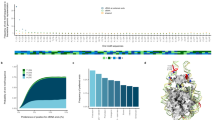Abstract
Cells die at different rates as a function of disease state, age, environmental exposure, and behavior [8, 10]. Knowing the rate at which cells die is a fundamental scientific question, with direct translational applicability. A quantifiable indication of cell death could facilitate disease diagnosis and prognosis, prioritize patients for admission into clinical trials, and improve evaluations of treatment efficacy and disease progression [1, 4, 14, 16]. Circulating cell-free DNA (cfDNA) in the bloodstream originates from dying cells and is a promising non-invasive biomarker for cell death.
Access this chapter
Tax calculation will be finalised at checkout
Purchases are for personal use only
Similar content being viewed by others
References
Bowser, R., Turner, M.R., Shefner, J.: Biomarkers in amyotrophic lateral sclerosis: opportunities and limitations. Nat. Rev. Neurol. 7, 631–8 (2011)
Houseman, E.A., Molitor, J., Marsit, C.J.: Reference-free cell mixture adjustments in analysis of DNA methylation data. Bioinformatics 30, 1431–1439 (2014)
Houseman, E.A., et al.: DNA methylation arrays as surrogate measures of cell mixture distribution. BMC Bioinformatics 13, 86 (2012). https://doi.org/10.1186/1471-2105-13-86
Joka, D., et al.: Prospective biopsy-controlled evaluation of cell death biomarkers for prediction of liver fibrosis and nonalcoholic steatohepatitis. Hepatology 55, 455–64 (2012)
Lehmann-Werman, R., et al.: Identification of tissue-specific cell death using methylation patterns of circulating DNA. Proc. Natl. Acad. Sci. 113, E1826–E1834 (2016)
Liu, X., et al.: Comprehensive DNA methylation analysis of tissue of origin of plasma cell-free DNA by methylated CpG tandem amplification and sequencing (MCTA-Seq). Clin. Epigenetics 11, 93 (2019)
Lokk, K., et al.: DNA methylome profiling of human tissues identifies global and tissue-specific methylation patterns. Genome Biol. 15, r54 (2014). https://doi.org/10.1186/gb-2014-15-4-r54
Meier, P., Finch, A., Evan, G.: Apoptosis in development. Nature 407, 796–801 (2000)
Moss, J., et al.: Comprehensive human cell-type methylation atlas reveals origins of circulating cell-free DNA in health and disease. Nat. Commun. 9, 1–12 (2018)
Nagata, S.: Apoptosis by death factor. Cell 88, 355–65 (1997)
Rahmani, E., Schweiger, R., Shenhav, L., Eskin, E., Halperin, E.: A Bayesian framework for estimating cell type composition from DNA methylation without the need for methylation reference. In: Sahinalp, S.C. (ed.) RECOMB 2017. LNCS, vol. 10229, pp. 207–223. Springer, Cham (2017). https://doi.org/10.1007/978-3-319-56970-3_13
Rahmani, E., et al.: Sparse PCA corrects for cell-type heterogeneity in epigenome-wide association studies. Nat. Methods 13, 443–445 (2016)
Snyder, M.W., Kircher, M., Hill, A.J., Daza, R.M., Shendure, J.: Cell-free DNA comprises an in vivo nucleosome footprint that informs its tissues-of-origin. Cell 164, 57–68 (2016)
Turner, M.R., et al.: Mechanisms, models and biomarkers in amyotrophic lateral sclerosis. Amyotroph. Lateral Scler. Frontotemporal Degener. 14, 19–32 (2013)
Verber, N.S., et al.: Biomarkers in motor neuron disease: a state of the art review. Front. Neurol. 10, 291 (2019)
Vila, M., Przedborski, S.: Targeting programmed cell death in neurodegenerative diseases. Nat. Rev. Neurosci. 4, 365–375 (2003)
Author information
Authors and Affiliations
Corresponding author
Editor information
Editors and Affiliations
Rights and permissions
Copyright information
© 2020 Springer Nature Switzerland AG
About this paper
Cite this paper
Caggiano, C. et al. (2020). Estimating the Rate of Cell Type Degeneration from Epigenetic Sequencing of Cell-Free DNA. In: Schwartz, R. (eds) Research in Computational Molecular Biology. RECOMB 2020. Lecture Notes in Computer Science(), vol 12074. Springer, Cham. https://doi.org/10.1007/978-3-030-45257-5_21
Download citation
DOI: https://doi.org/10.1007/978-3-030-45257-5_21
Published:
Publisher Name: Springer, Cham
Print ISBN: 978-3-030-45256-8
Online ISBN: 978-3-030-45257-5
eBook Packages: Computer ScienceComputer Science (R0)




